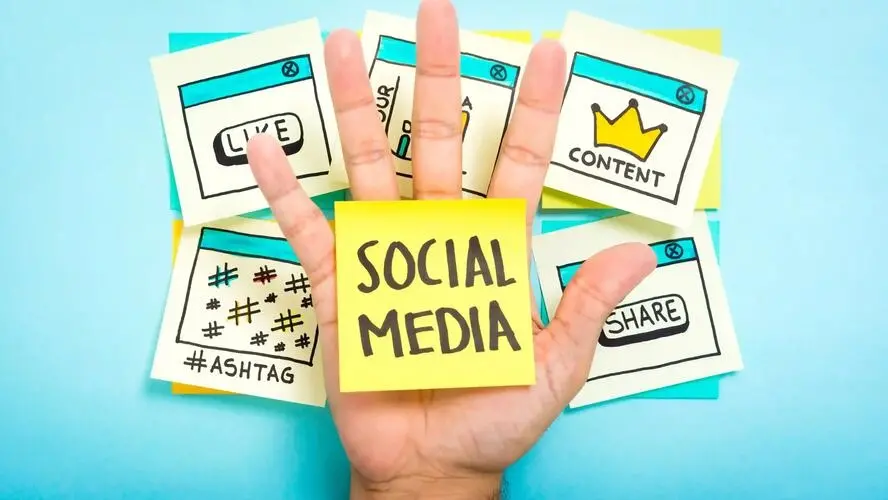When it comes to social media, the power of visuals can not be overstated. The majority of people recall visual content for a lot longer than written text, which is why your marketing strategy should include lots of attractive images.
But, best practices for online content are always changing, and with them the image size guidelines for different social media platforms. Marketers often find it challenging to post high-quality images that look great on all devices.
That’s why I’ve written this guide - to help you keep up with the changes so you can get maximum exposure for your content. Read on as we look at the best image sizes for all major social media outlets.
But first, you may be wondering why it’s even important to get the image sizes right on different platforms.
Well, the answer is simple. If you don't use proper social media image sizes, it will disrupt the user experience regardless of which platform is being used. By following the recommended image sizes for each social site, you ensure that all your content is presented in a clear and transparent way.
No important information is accidentally cropped out by the platform’s automatic image resizers. Also, when all your posts are adjusted to each platform, it makes your images appear more professional and helps to boost your branding efforts.
With that out of the way, let’s get into our list of social media sites and the correct image sizes for each one.
1. Facebook Image Sizes
We’ll start off our list with the world's largest and most popular social media platform. Facebook employs many different image sizes on its site, and their size depends on location and use.
The image below shows a cover image and profile image for Verpex on Facebook:
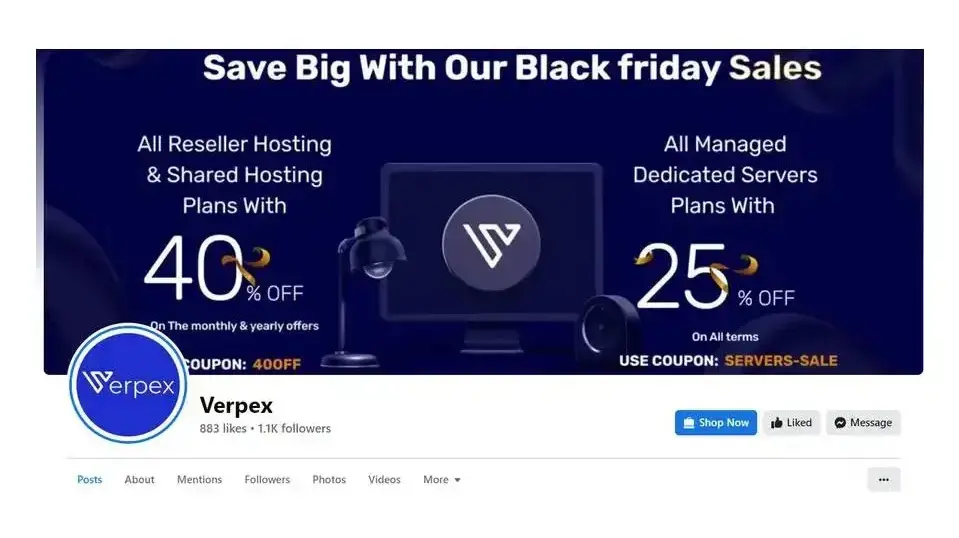
Facebook image sizes are as follows:
Profile Image: 170 x 170 pixels
Business Page Profile: 180 x 180 pixels
Cover Image: 851 x 315 pixels
Posts and Timeline Image: 1200 x 630 pixels
This is an example of a timeline image from Verpex:
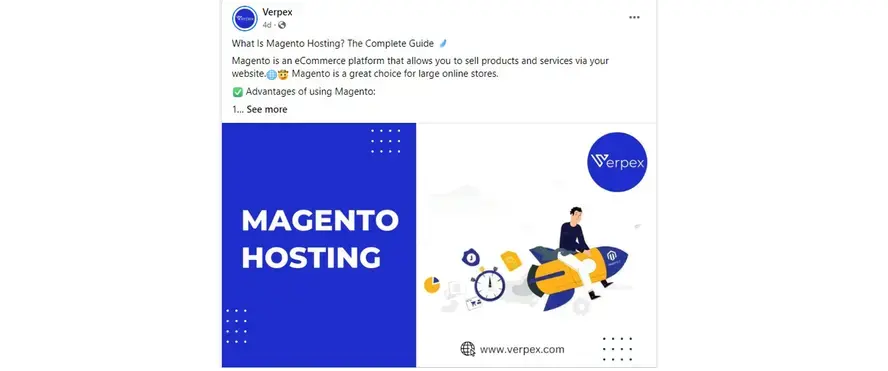
Shared Link Image: 1200 x 628 pixels
- Square Image: 154 x 154 pixels in feed (116 x 116 on page)
- Rectangular Image: 470 x 246 pixels in feed (484 x 252 on page)
Event Cover Image: 1200 x 628 pixels
Fundraiser Image: 800 x 300 pixels
Group Cover Image: 1640 x 856 pixels
Highlighted Image: 1200 x 717 pixels
Facebook Fundraiser: 800 x 300 pixels
Stories: 1080 x 1920 pixels
Marketplace Images: 1200 x 1200 pixels
Facebook Panorama or 360 Image: 30,000 pixels in any dimension, less than 135,000,000 pixels in total size
Facebook Ads Image Sizes
Facebook Feed Ads: 1080 x 1080 pixels (Minimum file size: 600 x 600 pixels)
Facebook Right Column ads (Desktop-only ads): 1080 x 1080 pixels (Minimum file size: 254 x 133 pixels)
Instant Articles Ads: 1080 x 1080 pixels
Facebook Marketplace Ads: 1080 x 1080 pixels
Facebook Search Ads : 1080 x 1080 pixels (Minimum file size: 600 x 600 pixels)
Sponsored Messages Ads: 1080 x 1080 pixels
Messenger Inbox Ads: 1080 x 1080 pixels (Minimum size: 254 x 133 pixels)
2. Twitter Image Sizes
In Twitter's help center, you'll find the recommended image sizes for header and profile images. However, there isn't any specific recommendation for feed images. Instream images are displayed at 600 x 335 pixels, but users can click them and view them as large as 1200 x 675 pixels.
Make sure your profile images on different social media websites match to maintain brand consistency. As you can see from the example below, Verpex.com on Twitter maintains seamless branding across different social media websites:

Profile Images: 400 x 400 pixels
Header Images: 1500 x 500 pixels
In-Stream Images: 1600 x 900 pixels
Twitter Card Image: 120 x 120 pixels (minimum)
Recommended image sizes by types of Tweets:
Image from a Tweet with shared link: 1200 x 628 pixels
Tweet sharing a single image: 1200 x 675 pixels (this is recommended, but images with standard aspect ratios won’t be cropped)
Tweet sharing two images: 700 x 800 pixels (both images)
Tweet sharing three images: Left image - 700 x 800 pixels, Right images - 1200 x 686 pixels
Tweet sharing four images: 1200 x 600 pixels (each image). This is the maximum number of images you can have on one Tweet
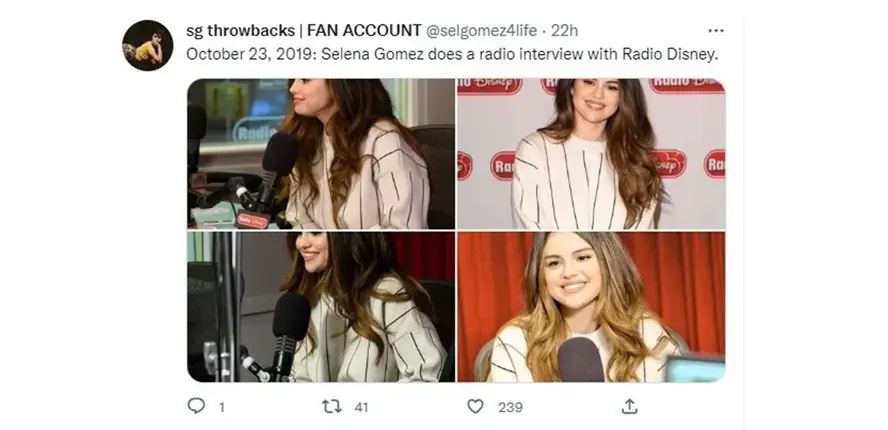
Twitter Ads Image Sizes
Website Card Image: 800 x 418 pixels
App Card Image: 800 x 800 pixels
Carousels: 800 x 800 pixels
Direct Message Card: 800 x 418 pixels
Conversion Card: 800 x 418 pixels
3. Instagram Image Sizes
On Instagram, images are displayed both horizontally and vertically-oriented.
Here are the guidelines for Instagram image sizes:
Profile Images: 320 x 320 pixels
Instagram Photo Thumbnail: 161 x 161 pixels
Instagram Stories: 1080 x 1920 pixels
Carousels:
- Landscape: 1080 x 566 pixels
- Portrait: 1080 x 1350 pixels
- Square: 1080 x 1080 pixels
Instagram Reels: 1080 x 1920 pixels
IGTV Cover Photo: 420 x 654 pixels
Feed Images:
- Landscape: 1080 x 566 pixels
- Portrait: 1080 x 1350 pixels
- Square: 1080 x 1080 pixels
Instagram Ads Image Sizes
- Landscape: 1080 x 566 pixels
- Square: 1080 x 1080 pixels
4. YouTube Image Sizes
YouTube is more about videos than images, but there are still a lot of places within the platform's interface where you can use images, like we do on Verpex Official YouTube channel.
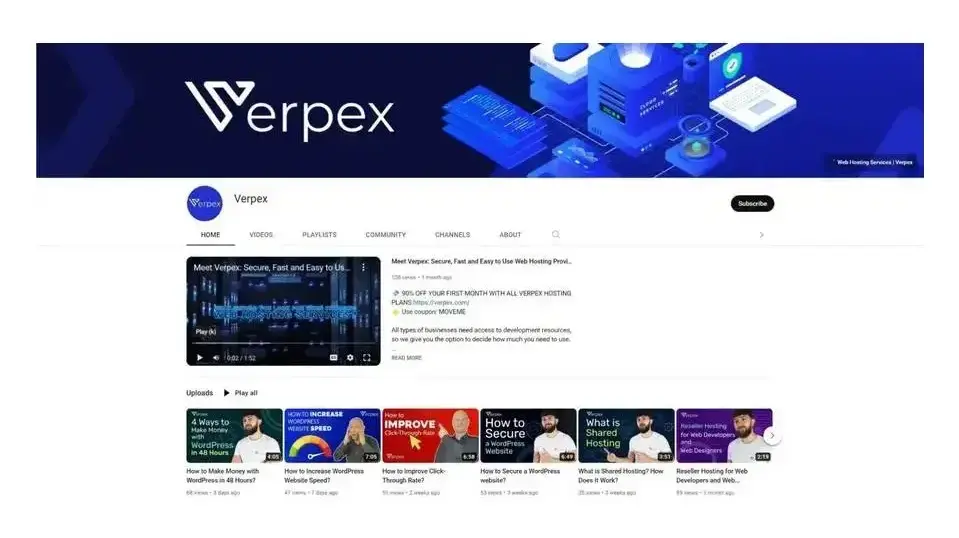
Here are the recommended image sizes for YouTube:
Profile Image: 800 x 800 pixels
Banner Image: 2048 x 1152 pixels
Video Thumbnail Size: 1280 x 720 pixels
Display Ads: 300 x 250 pixels
Overlay Ads: 480 x 60 pixels
Companion Banner Ads: 300 x 250 pixels
5. LinkedIn Image Sizes
LinkedIn can be a valuable source of leads for your business, and one way to grab people's attention is by using high-quality images of the right size.
Listed below are LinkedIn's set of recommended image sizes:
Personal Profile Image: 400 x 400 pixels
Background Header/Cover Image: 1584 x 396 pixels
Custom Modules: 502 x 282 pixels
Company Photos: 900 x 600 pixels
Post Image:
- Square: 1200 x 1200 pixels
- Portrait: 1080 x 1350 pixels
LinkedIn Stories: 1080 x 1920 pixels
Blog Post Link Images/Shared Link Image: 1200 x 627 pixels
Company Pages:
Company Logo Image: 300 x 300 pixels
Company Cover Image: 1128 x 191 pixels
Life Tab:
- Main Image: 1,128 x 376 pixels
- Company Photos: 900 x 600 pixels
- Custom Modules: 502 x 282 pixels
Square Logo: 60 x 60 pixels (minimum)
LinkedIn Ads Image Sizes
Company Logo Ads: 100 x 100 pixels
Spotlight Logo Ads: 100 x 100 pixels
Spotlight Custom Background: 300 x 250 pixels
Sponsored Content Images: 1200 x 627 pixels
Sponsored Content Carousel Images: 1080 x 1080 pixels
6. Pinterest Image Sizes
Pinterest uses lots of different types of image sizes and aspect ratios in various areas of the platform. The website's best practice information makes it clear what the best size is for your images.
Pinterest’s recommended image sizes are as follows:
- Profile Image: 165 x 165 pixels
Profile Cover Image: 800 x 450 pixels (minimum)
Standard Pins: 1,000 x 1,500 pixels
Square Pins: 1,000 x 1,000 pixels
Long Pins: 1000 x 2100 pixels
Infographic Pins: 1000 x 3000 pixels
Story Pins: 1080 x 1920 pixels
Fleets: 1080 x 1920 pixels
Collections Pins: 1000 x 1000 or 1000 x 1500 pixels
Board Display:
- Large Thumbnail: 222 x 150 pixels
- Small Thumbnail: 55 x 55 pixels
Pinterest Ads Image Sizes
App Install Ads: 1000 x 1500 pixels
Carousel Pins and Ads: 1,000 x 1,000 pixels, or 1000 x 1500 pixels
Shopping Ads: 1000 x 1500 pixels
7. TikTok Image Sizes
Like YouTube, Tik-Tok is all about videos, but they do have image guidelines for profile image sizes, which as follows:
- Profile Image: 200 x 200 pixels
8. Snapchat Image Sizes
Snapchat is a great platform for brands to tell stories via fun filters and engaging content that disappears after 24 hours.
Here are the platform’s image size guidelines:
Shared Images: 1080 x 1920 pixels
Geofilters: 1080 x 1920 pixels
Stories: 1080 x 1920 pixels
Snapchat Ads Image Sizes:
Snapchat Ads: 1080 x 1920 pixels
Geofilter: 120 x 120 pixels (minimum)
9. Google My Business Image Sizes
Company logo, Cover photo, and Business photo: 720 x 720 pixels (250 x 250 pixels minimum resolution)
10. Tumblr Image Sizes
Profile Image: 128 x 128 pixels
Cover Image: 3000 x 1055 pixels
Image Posts: 1280 x 1920 pixels
Free Tools to Create Appealing Social Media Images With Accurate Dimensions
If you don't have the necessary photography and photo editing skills, never fear. There are image editing tools that simplify the process of sizing your images.
These include tools like:
Canva
A free, beginner-friendly image design tool with powerful online graphic design features for your website.
Adobe Spark
Now Adobe Express, this is another powerful image editing tool to help you stand out on social media.
Stencil
The web’s favorite online graphic design tool with basic and advanced features for image resizing.
Pablo
A quick and easy way to design engaging and visually appealing images for your social media campaigns.
PicMonkey
Design and edit images in real-time using simple drag-and-drop photo editing software.
Snappa
Quick and easy cloud-based graphic design software for beginners and experts alike.
These tools are designed for ease of use, and you'll be able to resize all your images quickly and easily even if you have zero technical experience. They come with drag-and-drop editors that you can use to not only change image sizes but also add filters, text, stickers, and overlays to help spice up your images.
Most of the platforms listed above offer a free trial so you can test out the platform before committing to a paid subscription.
In addition to image editing, some of the tools integrate with stock image libraries like Shutterstock to give you access to stock image galleries with millions of high-quality, royalty-free images to use for your social media campaigns.
Conclusion
This guide has all the information you need to ensure that you never upload a photo to your social media feed that doesn't look as good as it possibly can.
Some websites allow you to upload your images without adhering to a specific set of parameters. That's because they resize and compress the images in order to save space and bandwidth.
While this can save you a lot of time, it also means that the resize/optimization settings on the website or server are often set up for maximum efficiency rather than producing the best quality image output.
For this reason, it's best for you to follow the recommendations in this guide to prep your images at the recommended sizes for each website. This will help you avoid (or at least minimize) the loss of quality so that your images end up looking their best.
Over to you. Has this article helped you understand which image sizes are optimal for each social media site? Share your thoughts below!
Frequently Asked Questions
Can I afford a website builder?
Yes. Besides paid website builders, there are also free ones; however, they come with fewer options.
How do I choose a design for my website?
One of the most important things when creating a website for your art is the design. Even though your pieces of art might be amazing, people will leave if your site is hard to navigate. This is why it’s important that the site is easy on the eyes and easy to navigate.
What are the customization options with a website builder?
Although website builders usually have some customization settings, like templates, fonts, margins editing, and so on, when compared to CMSs, it lacks customization options.
What is the best way to display my art on my website?
Your website can be used for many things; however, you need to keep in mind that you created your website to promote your art. Don’t get wrapped up in all the things around your site and forget to put the primary focus on your art.
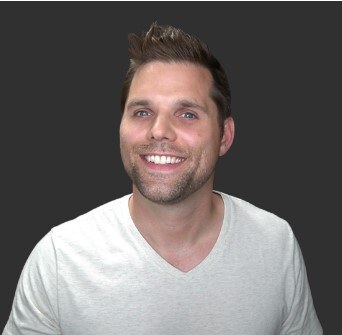
Ron Stefanski is a website entrepreneur and marketing professor who has a passion for helping people create and market their own online business. You can learn more from him by visiting OneHourProfessor.com
View all posts by Ron Stefanski















